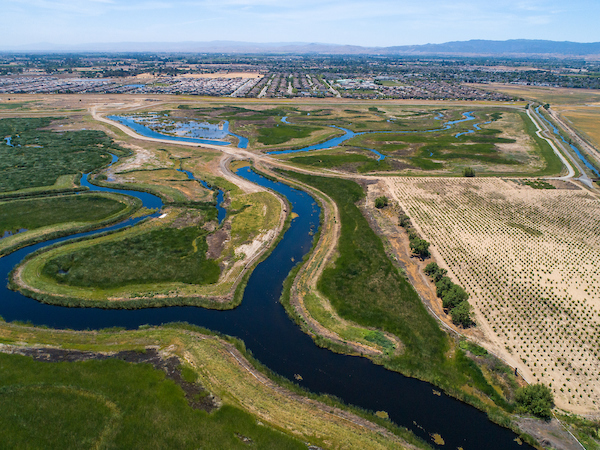Aerial view of the Dutch Slough Tidal Marsh Restoration Project.
SACRAMENTO, Calif. – As part of an ongoing effort to protect and restore critical habitat in the Sacramento-San Joaquin Delta, the Department of Water Resources (DWR) has restored more than half of the 1,187 acres of former grazing and dairy lands into rich habitat for fish and wildlife as part of the Dutch Slough Tidal Marsh Restoration Project. The project is one of the largest multi-benefit freshwater tidal marsh restoration efforts implemented.
The Dutch Slough Project aims to re-establish a rich ecological network that would boost survival rates of endangered fish species and wildlife while also protecting neighborhoods against flooding. With the first phase now complete, the project has opened the Dutch Slough site to natural daily tides, creating a tidal wetland that provides a safer environment for salmon, splittail, and other endangered fish species. Additionally, the Dutch Slough site improves flood protection to surrounding neighborhoods such as the City of Oakley, acting as a buffer against rising sea levels triggered by climate change.
“Restoration efforts like the Dutch Slough Project are essential for providing greater drought resiliency, safeguarding communities against the long-term effects of climate change, and protecting, restoring and enhancing the environmental quality of the Sacramento-San Joaquin Delta,” said DWR Deputy Director of Integrated Watershed Management Kris Tjernell.
DWR, in collaboration with partner agencies, worked to raise the site to tidal elevations to create the foundation needed to re-establish marsh habitat. DWR also collaborated with River Partners and local native plant nurseries to install more than 40,000 trees, shrubs, flowering plants, and grasses as well as approximately 25,000 tule plugs that were grown at on-site nurseries. Additionally, a flood control levee was installed at the southern end of the property to provide flood protection to neighboring homes, also allowing DWR to breach the site in five locations to allow tidal flows to enter the site.
In addition to providing critical habitat, the Dutch Slough site will also provide information to the scientific community. The project was designed to help scientist and others learn about restoration in the Delta and will serve as a living laboratory to advance understanding of tidal habitat. This knowledge will help inform future restoration projects, making them more cost-effective and ecologically valuable.
Additionally, 55 acres of the south-central portion of Dutch Slough will be developed by the City of Oakley into a community park, which will connect to a loop trail that will allow visitors to hike, bike and birdwatch. The park will feature interpretive signs to educate visiting schools and community groups about Dutch Slough’s history and marsh ecosystems.
“The Dutch Slough Tidal Marsh Restoration Project is just about 20 years in the making and it’s thanks to the hard work and dedicated partnerships between local, state, and federal agencies,” said DWR’s Dutch Slough Project Manager Katie Bandy.
The second phase of the project, which will include restoration of the remaining acres, is expected to begin in 2023 to the east of the current site. This effort is made possible by support from the U.S. Environmental Protection Agency, U.S. Fish and Wildlife Service, Reclamation District 2137, State Coastal Conservancy, California Department of Fish and Wildlife, City of Oakley, East Bay Regional Park District, the Delta Conservancy, Natural Heritage Institute, American Rivers, and River Partners.
The Dutch Slough project is just one of many efforts being implemented by California that contribute to the California EcoRestore Initiative, a multi-agency endeavor to restore more than 30,000 acres of wildlife habitat in the Delta. The project is directly connected to DWR’s Delta Levees Program as part of its legislative mandate to provide “net habitat improvement” in the Delta.
For more information on other restoration projects, please visit California EcoRestore.
Additional Resources
- Dutch Slough Fact Sheet
- Photos are available for download at DWR’s Pixel Library
- Dutch Slough Tidal Restoration Project Webpage
Contact:
Akiela Moses, Department of Water Resources
916-820-7669 | Akiela.Moses@water.ca.gov
